Squash Bug: Damage, Identification and Control (Pictures)
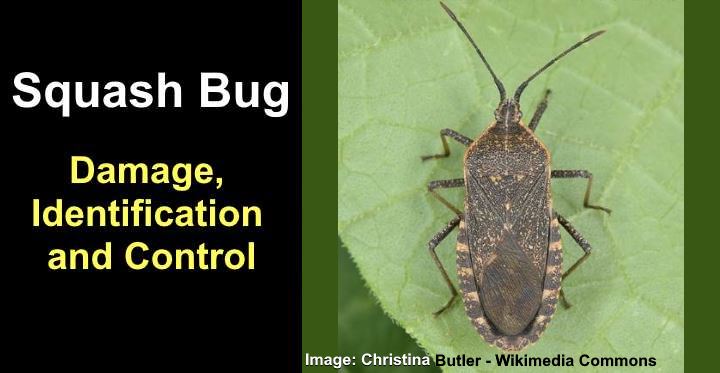
Squash bugs are destructive pests in gardens if you grow pumpkins, zucchini, squash plants, and other cucurbit plants. Squash bugs are small, flat-backed dark gray or brown insects with identifiable elongated oval bodies. Getting rid of squash bugs fast is vital to prevent them from destroying your crops. Natural squash bug control methods include hand picking, diatomaceous earth, and neem oil sprays.
Killing squash bugs and preventing the pests from returning requires a multi-method approach. In addition to natural insecticides, it’s crucial to avoid attracting the plant-destroying bugs. Total squash bug eradication can include using row covers, companion planting, and not mulching around squash or pumpkins plants.
This article is a guide on how to avoid squash bug infestations in your vegetable patch. As well as natural methods of getting rid of squash bugs, you’ll find about their life cycle. This way, you can use an integrated squash bug control strategy to eliminate the pesky bugs from your garden.
Squash Bug (Anasa tristis) Facts
A squash bug is a small insect in the genus Anasa and family Coreidae. Squash bugs have a recognizable flat back, grayish-brown body and measure around 0.6” (1.5 cm) long. A squash bug can do considerable damage by sucking the sap from leaves, causing them to wilt and die.
As the insect’s name implies, squash bugs mainly feed on pumpkins and summer and winter squash plants. However, you will also find squash bug eggs and adult bugs on zucchini, cucumbers, cantaloupe melons, and watermelons. The insects are sometimes called squash beetles.
Squash bugs emit a foul stench when crushed. Because of the unpleasant odor, some people also give squash bugs the name stink bugs. Although squash bugs and stink bugs look the same and smell awful when you crush them, they are unrelated.
Squash Bug Control
The most effective way to control squash bugs is by removing or scraping off the egg clusters before they hatch. Then ground beetles will feed on the eggs and squash bug nymphs. Additionally, you should check the undersides of leaves and remove any adult squash bug by hand.
When you remove the adult squash bugs, drop them in a bucket of soapy water to kill them for good. When it comes to keeping squash bug populations under control, prevention is key to ensure a bumper crop of squash plants.
What Do Squash Bugs Look Like?
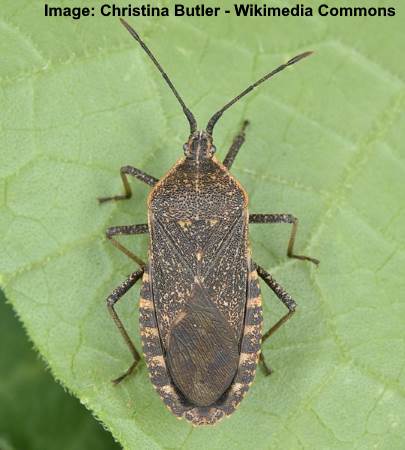
Squash bug (Anasa tristis)
A squash bug adult has a flattened dark gray oval or egg-shaped body and measures around 0.6” (1.5 cm) long. The squash pests have 3 pairs of dark legs and two antennae. You may notice a dark U or V-shaped marking near the head and two pronounced dots on the back.
Squash Bugs vs. Stink Bugs
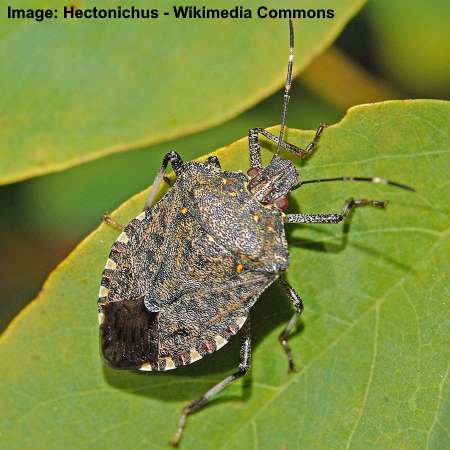
Stink bug (Halyomorpha halys)
Squash bugs and stink bugs have similar characteristics and it’s easy to confuse them. For example, both emit a foul odor when crushed and they look alike. You can tell squash bugs apart from stink bugs because the squash bug adult has a narrower body and only feeds on cucurbit plants.
Squash Bug Life Cycle
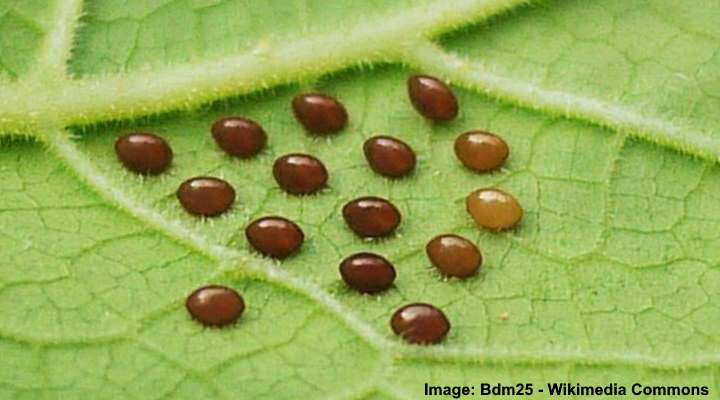
Squash bug eggs
A squash bug life cycle starts when female squash bugs lay oval, bronze-colored eggs on the underside of cucurbit leaves in late spring. Clusters of eggs contain up to 18 eggs and are found where thick leaf veins form a V shape. Squash bug eggs hatch after seven to nine days.
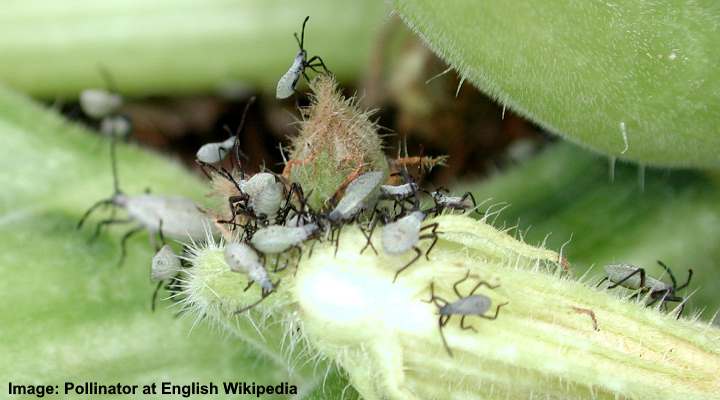
Squash bug nymphs
After the squash bug nymphs hatch in summer, they go through five stages (instars) before reaching adulthood. It takes four to six weeks for the nymphs to reach maturity. Squash bug nymphs are a light grayish-white color and turn darker gray when they become adult pests.
Adult squash bugs can live for up to four months. The destructive insect pest overwinters under garden debris, mulch, log piles, and under dead squash vines.
There is only one squash bug generation per year, so with persistence and determination, it’s possible to reduce squash bug populations to a minimum.
Where Do Squash Bugs Come From?
Squash bugs can fly and will often fly from nearby gardens if you grow any type of plant from the Cucurbitaceae family. This means that squash bugs can invade your vegetable patch from anywhere. Adult pests will also crawl to nearby squash plants or emerge from mulch in spring to lay more eggs.
Where Do Squash Bugs Live?
The foliage of pumpkin, zucchini, and other squash varieties are the home of squash bugs. The female bugs lay eggs on the underside of leaves and the squash nymphs will live there initially. Adult squash bugs live under the leaves of squash vines, mulch, rocks, or plant debris.
What Do Squash Bugs Eat?
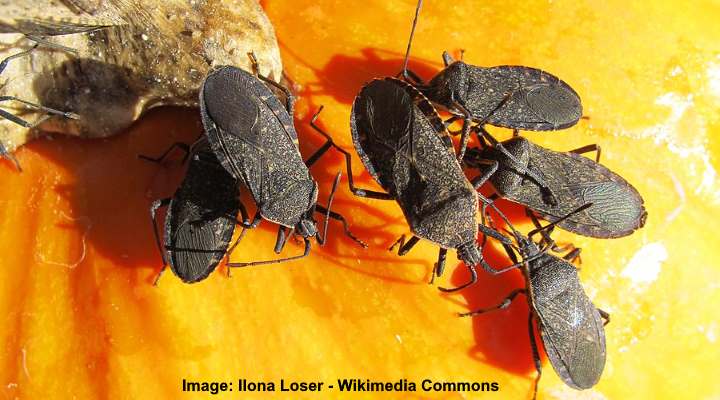
Squash bugs gathering on a pumpkin
Squash bugs feed mainly on squash and pumpkin plant leaves. The destructive insect pest will also destroy zucchini, cucumber, and melon plants. The bug uses its sharp, sucking mouth-parts to inject toxins into plant foliage and suck out the sap. Squash plant leaves eventually wilt, turn brittle and die.
Squash Bug Identification
To identify a squash bug, look for dark gray or brown insects with a flat back crawling on the underside of leaves on pumpkin or squash vines. The pests have an elongated oval body with a spotted back and triangular markings on it. Squash bugs measure up to 0.6” (1.5 cm) long.
What Does Squash Bug Damage to Plants Look Like?
The feeding activity of squash bugs causes damage such as yellow spots to appear on squash and pumpkin leaves. Extensive squash bug damage causes the leaves to yellow, wilt, and die. Additionally, the plant may produce fewer and smaller crops.
How to Get Rid of Squash Bugs from Plants
Getting rid of squash bugs after the nymph stage can be challenging. It’s always best to use natural squash bug control methods. This way, you prevent potentially harmful chemicals from entering the food chain. Also, bugs can build up resistance to chemical pesticides, making them ineffective at getting rid of squash bugs.
Here are some ways to eradicate squash bugs from your garden.
Remove Squash Bugs from Plants by Hand
The best natural method for squash bug extermination is to pick the adults and nymphs from leaves and drop them in a bucket of soapy water. If there is a cluster of bugs on a squash plant leaf, you can cut the entire leaf and kill them in soapy water.
Once the squash bugs are dead, you can dispose of them in compost or pour over weeds.
Use Diatomaceous Earth to Eradicate Squash Bugs
Diatomaceous earth (DE) is a natural squash bug killer because it destroys its outer layer. Use food grade DE to sprinkle over your squash plant vines and leaves. When the bugs encounter the abrasive white powder, the DE causes the bugs to dry out and die.
There is an important thing to remember for diatomaceous earth to be effective for squash bug control. DE only works when the ground and leaves are completely dry. Therefore, you must reapply the powder after rainfall or watering your garden when the soil is dry again.
Use Duct Tape for Quick Bug Removal
You can make a natural squash bug trap by using duct tape. All you need to do is roll the tape so that the sticky side is facing out. You can easily make many traps and place them in strategic places around your squash plants.
Duct tape can also be used to remove squash bug egg clusters from leaves. Press a short section of tape on to the eggs and gently peel it away. Most of the brown bug eggs should stick to the heavy-duty tape.
Insecticidal Soap Spray for Killing Squash Bugs
An organic soap spray kills squash bugs by breaking down their outer shell. You can buy a commercial organic insecticidal soap as a foliar application. Or you can make your own soapy spray with dish soap or liquid Castile soap to kill squash bugs on plants.
To make a squash bug spray, mix 1 tsp. liquid Castile soap with 1 quart (1 l) of water in a spray bottle. Spray directly onto squash, pumpkin, or zucchini plants to kill the squash bugs on contact.
Even if some survive, the soap will slow them down and it will be easier to catch them.
Spray Squash Bugs with a Neem Oil Solution
Neem oil is a natural organic pesticide that can help to eradicate squash bugs. To make a natural insecticide spray, combine 2 tsp. neem oil and 1 tsp. dish soap with a quart (1 l) of water in a spray bottle. Liberally spray the squash plant foliage with the neem solution to kill off squash nymphs and adults.
Related reading: How to use neem oil to kill plant bugs.
In cases of heavy infestation, natural control methods may not always be 100 percent effective. In that case, you may have to look at commercially available insecticides if organic pesticides don’t work.
How to Prevent Squash Bugs
In your battle with squash bugs, early detection of nasty pests is key to preventing a severe infestation. In mid-spring, when females start to lay eggs, check the underside of cucurbit plant leaves every few days for egg clusters. Then, crush eggs that are attached to foliage and stems.
However, there are a few additional strategies that can help to prevent an infestation of squash bugs.
Prevent Squash Bugs by Planting Resistant Varieties of Squash Plants
The easiest way to prevent squash bugs is by planting squash bug resistant varieties of cucurbit plants. Some squash varieties resistant to squash bugs are Lemon Squash, Butternut Squash, and Zucchino Rampicante Squash. Other squash varieties include ‘Early Summer Crookneck,’ ‘Royal Acorn,’ ‘Butternut 23,’ and ‘Improved Green Hubbard.’
Use Row Covers to Deter Squash Bugs
Using floating row covers to cover your squash plants can help protect them from female bugs laying eggs. However, it’s good to remember that this pest control method is only useful early in the season. The issue with row covers is that they can prevent pollinators from pollinating flowers.
The best way to use row covers for squash bug prevention is to remove them when the vines start to bloom. Then, it’s vital to regularly inspect the underside of leaves for eggs and squash bug nymphs.
Alternatively, you could keep row covers on for longer in the season and hand pollinate flowers.
Companion Planting Can Help Prevent Squash Bugs
Growing plants that repel squash bugs can also be a strategy to prevent squash bugs from destroying your squashes and pumpkins. Plants that are said to repel squash pests are nasturtiums, marigolds, and white icicle radishes. Additionally, you could try fragrant herbs such as dill, lemon balm, peppermint, and parsley for bug prevention.
Another method of companion planting to reduce squash bug numbers is to grow crops that attract squash bug predators. For example, ladybugs and tachinid flies feed on squash pest larvae and nymphs. Plants that attract beneficial insects include sweet clover, cilantro, dill, carrots, and anise hyssop.
Of course, companion planting is just one tool in your efforts to eradicate squash bugs from your garden. However, combining various control methods can help to keep garden pests to a minimum.
Avoid Attracting Squash Bugs by Keeping Your Garden Clean
Adult squash bugs overwinter under dead plant material, debris, rocks, and log piles. By removing all unnecessary debris from your garden, you don’t give squash bugs a place to live. You also increase the chance that other predator bugs and animals find the pests and eat them.
Another way to prevent squash bugs is to remove all dead cucurbit plant matter in the fall. In most cases, it’s best to destroy or burn the dead squash and pumpkin foliage and stems rather than compost them. This way, you ensure that you eradicate as many adult squash bugs as possible.
As part of your fall garden clean up, tiling will help get rid of more garden pests that are hibernating in the ground.
Don’t Mulch Around Vegetables to Prevent Squash Bugs
To avoid providing the perfect environment for squash bugs to thrive, avoid mulching around squash, pumpkin, and zucchini plants. The thick layer of bark or straw is precisely where squash bugs thrive.
In addition, if you are battling with large numbers of squash bugs, try to remove as much mulch or ground cover plants as possible.
Squash Bug Control — FAQs
What’s the best way to prevent squash bugs from overwintering?
Adult squash bugs find places under plant debris, mulch, rocks, and piles of wood to spend the winter. In spring, the adults will emerge from hibernation, mate, and then lay hundreds of eggs on squash plants. Therefore, it’s important to remove all plant debris at the end of the growing season.
Do squash bugs bite?
No. Squash bugs do not sting or bite humans and you can safely pick them off squash plants without fear. They are not dangerous to people. The only thing to be aware of is that they will give off an awful odor if you crush them.
Find out how to prevent and control squash vine borer.
Related articles:
